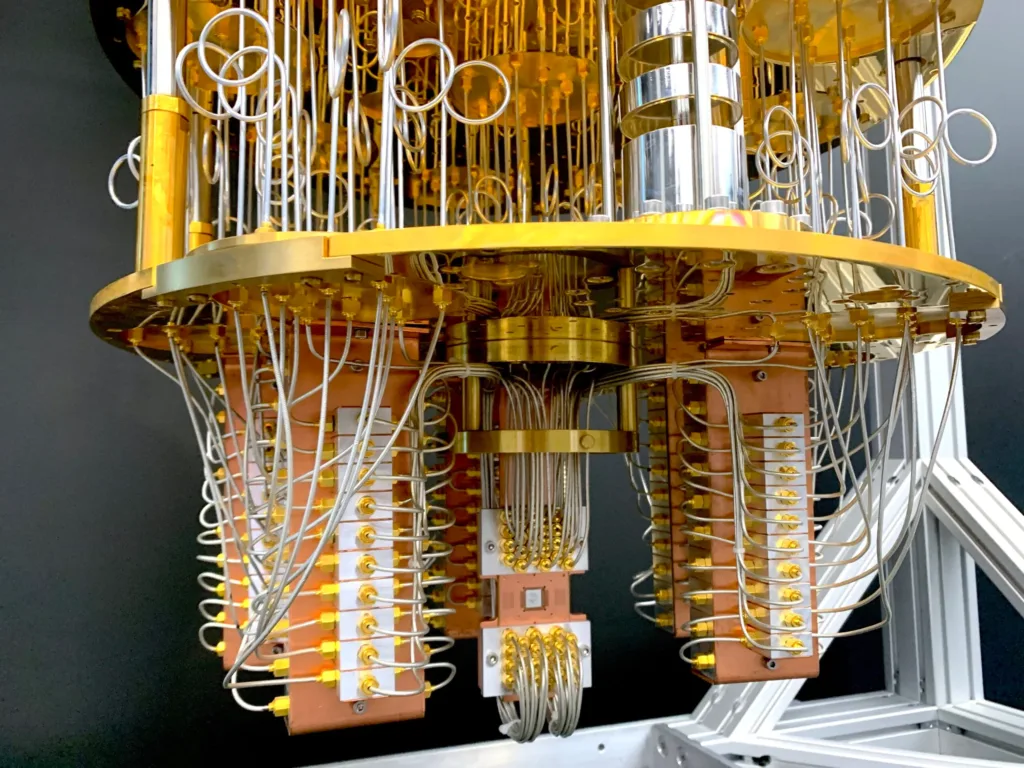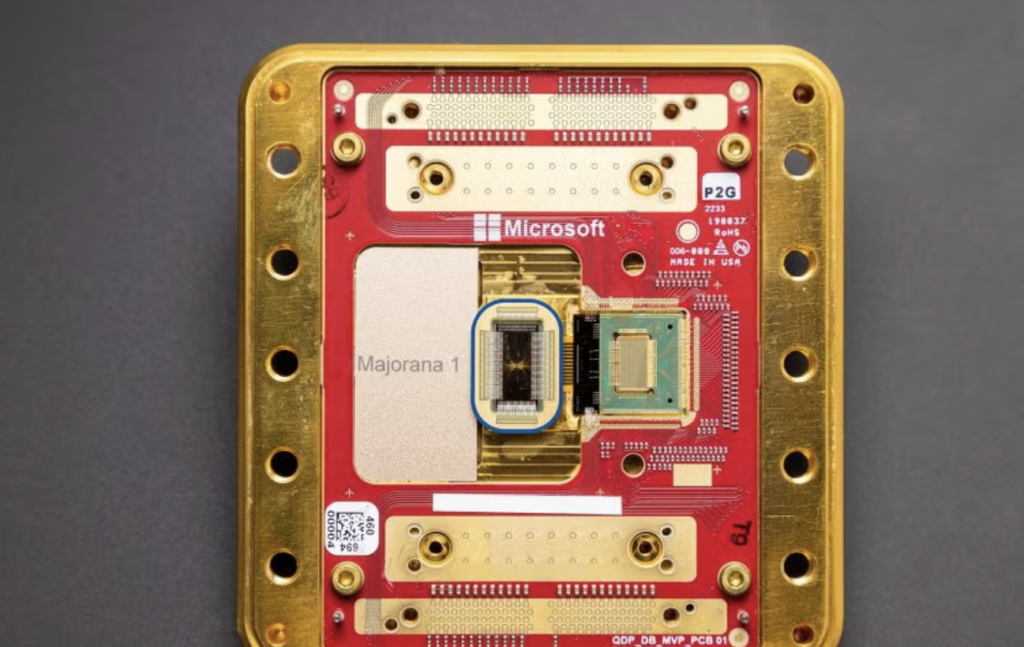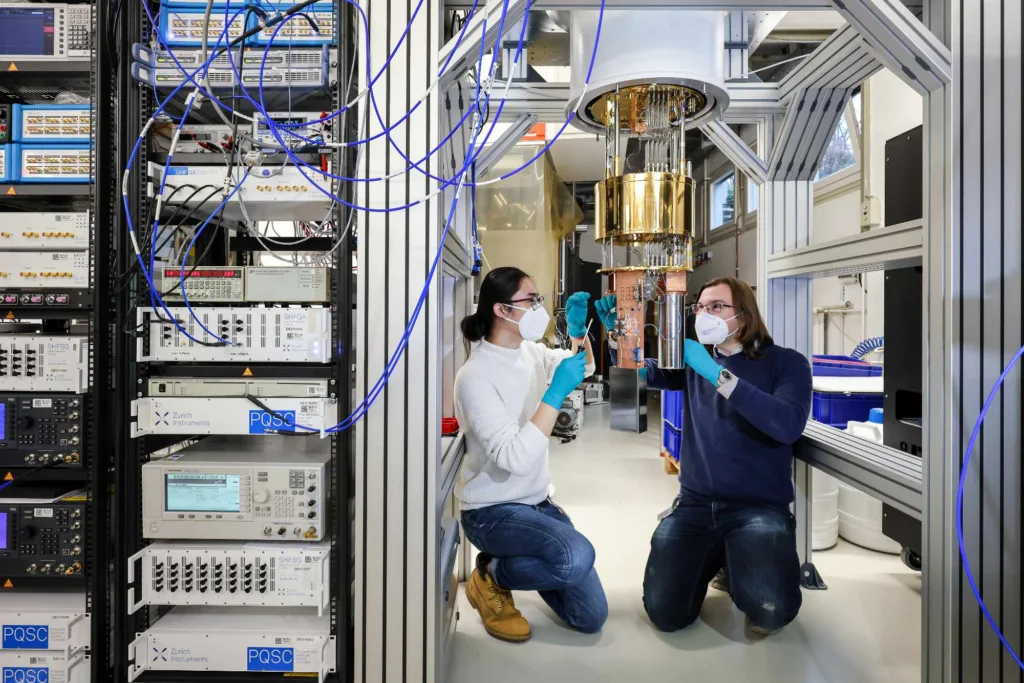Could the New State of Matter be the Future of Quantum Computing?
Definitions
- Fermions- particles that have a mass and are one of matter’s two main building blocks.
- Composite fermions- combinations of these fermions.
- Superconductors- according to Cade Metz of the New York Times, “are materials that conduct electricity without losing the energy they are transmitting.”
- Majorana- a particle that is its own antiparticle
- Antiparticles- subatomic particles that have the same masses as corresponding particles, but they have opposite charges
We’re all told growing up that the states of matter are solid, liquid, and gas. As we grow up, plasma and Bose-Einstein Condensates are added to that list, but what if I were to tell you that a new state of matter was just created, and it’s being used to advance quantum computing.
On February 19, Microsoft published a research paper in the science journal Nature, announcing that they created the Majorana-1 chip. The Majorana-1 chip is a microprocessor that uses a topological superconductor that yields particles that aren’t solid, liquid, or gas. Could this new state of matter be the key to the future of quantum computers?
History:
Thirty years ago, Jainendra Jain, a physicist at Penn State, pioneered a theory about a new state of matter. They called this theory the fractional quantum Hall effect and said that it was a liquid of composite fermions. These fermions can create a superconductor under the right conditions. Theorists then predicted that under the right conditions, these composite fermions could make a superconductor that encloses a Majorana.

Standard Versus Quantum Computing
Normal computers use “bits.” These are the 0’s and 1’s that make up data. On the other hand, quantum bits, or qubits, can be a 0, a 1, or a superposition, such as being a 0 and a 1 simultaneously. Together, these qubits drastically increase how quickly calculations can be made. In fact, if every computer in the world worked together, it would take decades to do what a quantum computer can do in just one day.
One of the main challenges in the world of quantum computers is interference either from the environment or from within the system itself. If there is interference, qubits can collapse and cause errors by going into a definite state, meaning they would turn into only a 1 or a 0. That’s where theorists bring in these strange Majorana particles.
Theorists believed that these Majorana particles could be applied to quantum computing to make them more fault-tolerant. This happens because when there are two Majorana particles together, they either make a whole fermion or nothing, acting as the 0’s and 1’s of a standard bit. However, unlike most other qubits, Jainendra Jan says “the information here can be stored non-locally in a topological fashion.” What this means is that the two Majorana particles making up a qubit can have distance between them. Since neither of them have all the information, local interference can’t turn them on or off. So, the qubits won’t lose their data because it can correct errors as it calculates, allowing quantum computing to be used by industries in the future.
The New Quantum Computer
In 1997, Alexei Kitaev, a Russian American physicist, first came up with the idea of combining superconductors and semiconductors. Microsoft has worked toward this idea in what has been its longest-running research project by combining the superconductors most quantum computers use with the classical computer’s semiconductor’s strengths.
Experimentalists have found that in the right conditions, such as being cooled to about four hundred degrees below zero, composite fermions can pair up to form a topological superconductor that contains the highly sought-after Majorana particles.
This topological superconductor, also called a topoconductor, is the new state of matter they created. A topoconductor is formed when a superconductor and a semiconductor are cooled to extremely low temperatures and then tuned with a magnetic field.
Far from the future?
Even with this exciting news involving a new state of matter that could revolutionize quantum computing, people shouldn’t get too excited yet. In fact, Microsoft’s Majorana-1 chip doesn’t actually show that composite fermions work as qubits because Jainendra Jain says it “focuses on Majorana particles in superconductor-semiconductor hybrid nanowires, not on Majorana particles in a composite-fermion superconductor.” However, it shows that the needed measurements for a Majorana particle-based computer are possible, showing a pathway to the future.
Also, the Majorana-1 chip is still in development. It is designed to have up to one million qubits, but right now it only contains eight. Microsoft claims that it has to put one hundred qubits into the chip to make it commercially viable. They are predicting that this will come in the near future, and based on their predictions this technology may be possible by 2030.
This technology could be used to advance research, improve energy efficiency, develop medicine, and much more. Some are still skeptical about it though because these computers are extremely powerful, so in the wrong hands the technology could pose a threat to national security.
Conclusion
While some scientists try to figure out if they should be developing this technology or not, others are off to the races, with Mirosoft, Google, Intel, IBM, and several foreign governments all trying to be the first to crack the code of quantum computing.
If Microsoft’s data is verified, it could revolutionize technology and make the future of science come much sooner than originally predicted. Whether one believes we should develop this technology or not, everyone can agree that these incredible leaps in technology showcase how much we have furthered our understanding of the quantum world. Now, we just have to wait and see what the future has in store for this exciting new technology.
References:
Fiveable. (n.d.). Antiparticle. Fiveable. Retrieved March 4, 2025, from https://fiveable.me/key-terms/principles-physics-iii-thermal-physics-waves/antiparticle
Klebanov, S. (2025, February 21). New state of matter just dropped? Morning Brew. Retrieved March 4, 2025, from https://www.morningbrew.com/stories/2025/02/21/new-state-of-matter-just-dropped
Metz, C. (2025, February 19). Microsoft Says It Has Created a New State of Matter to Power Quantum Computers. The New York Times. Retrieved March 4, 2025, from https://www.nytimes.com/2025/02/19/technology/microsoft-quantum-computing-topological-qubit.html
Porschke, T. (2025, February 26). Solid, Liquid, Gas, Plasma… Topoconductor? The Log. Retrieved March 4, 2025, from https://www.thelogcchs.com/post/solid-liquid-gas-plasma-topoconductor
Unacademy. (n.d.). Fermions and Bosons. Unacademy. Retrieved March 4, 2025, from https://unacademy.com/content/upsc/study-material/physics/fermions-and-bosons/
WennersHerron, A., & Berard, A. (2025, February 26). Q&A: Will Microsoft’s quantum ‘breakthrough’ revolutionize computing? Penn State. Retrieved March 4, 2025, from https://www.psu.edu/news/research/story/qa-will-microsofts-quantum-breakthrough-revolutionize-computing


